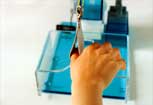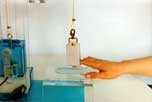
 Khyros
Khyros
Why Khyros?
The high performance levels demanded of instrumentalists, as well as an observation of professionals and students, led me to conclude that the exercises to study an instrument are not sufficient in themselves to develop the neuromuscular potential of an individual, nor to avoid the typical pitfalls of a musician. (small traumas, tendinitis, lack of endurance, lack of muscle quickness etc.).
After carrying out studies about the weight-training methods used by athletes of any kind, we remarked that there were amazing improvements in their performance thanks to such special training. We thus conceived special exercises for fingers, to be done with small weights (due to the extreme delicate and complex work they are called to perform). The development and power of muscles may be thus controlled by means of a gradual increase in the resistance offered.
What “Khyros” is
Khyros is a device for weight training with different sized weights, where a constant force is applied to the arm,  by allowing an isotonic neuromuscular exercise.
by allowing an isotonic neuromuscular exercise.
1. Variability of weights creating variable physical resistance
2. Wide range of movement
3. Possibility to train both active and reactive muscles
4. Possibility to train each finger individually in different ways to imitate the motor action necessary for the instrumental technique employed.
 Scientifically proven benefits from weight training:
Scientifically proven benefits from weight training:
On the skeletal-muscular system:
• Stimulus for the growth of long bones;
• Bone reinforcement thanks to the production of new bone matter and calcium salts;
• Increase in the articular cartilage thickness. Such thickening does not prejudice cartilage elasticity but actually increases it;
• The formation of new trabeculae in bones/in a bone;
• Strengthening of muscles and tendons, that increases their proteinic (bio-chemical) characteristics;
• Symmetrical development of muscles, that helps to prevent small traumas and to correct paramorphism;
• Improved muscle tone.
On the nervous system:
• Improved nerve control command system of muscles;
• Increase in the frequency and intensity of stimuli;
• Increase in the surface of motor plaque on muscle fibres;
• Increase in the diameter of motor nerve axon.
What is it for?
KHYROS can be used in the following fields:
a) Music (instrumentalists)
b) Medical – physiotherapeutic
c) Sport
Anyone who makes fine movements with hands will benefit from its use. In fact, not only will Khyros help to prevent and cure hand pathologies but it will also enhance hand motor functions, by ensuring a fingers' better response. Khyros follows the physiological development of hands. Its use is suggested for children from twelve to thirteen, i.e. when the muscle-bone system is able to respond to the gradual increase in stress due to weights.
Training method
The main method is to increase weights in repeated sequences, by alternating sequences with heavy weights (in order to develop strength and power) with periods using light weights (developing agility and endurance). The rhythm of the movements depends on the objectives sought.
Results
1. Increased finger agility
2. More strength and power
3. More elasticity
4. Improved resistance to strain
5. Improved motor sensitivity and improved precision in fingers' movement (that for pianists means a better touch)
6. Improved finger response to psychomotor commands
Testimonials
Professor Carlo Bufalini – Florence (Head of hand surgery and reconstructive microsurgery – CTO Florence)
Khyros has been of help to us in various circumstances for the segmentary movement of hand articulation and in treatments aimed at improving the speed of fine movements…
Professor Giuseppe Montanari – Gubbio (Doctor of Sports Medicine – Univ. of Chieti) co-ordinated a research on the effects of the use of Khyros on a sample of ten musicians. The positive results have been the subject of a scientific report presented at the National Congress of the National Association of Specialists in Sports Medicine of the University of Chieti and the Italian Society of Physical and Rehabilitative Medicine (Gubbio, June 21-24, 1992).
Positive opinions have been expressed by:
Professor Renzo Mantero – Savona (Head of Hand Surgery, S. Paolo di Savona Hospital)
Professor Alberto Freddi – Terni (Head of Neurophysiological Pathology and Co-ordinator of the Department of Rehabilitation, S. Maria of Terni Hospital)
Professor Carlo Perfetti – Vicenza (Head of Traumatology, Schio Hospital)
M.d.S. Stelvio Beraldo – Rieti (Director of the Study Centre of the Italian Federation of Wrestling and Judo – Rome
Maestro Carlo Minestrini – Perugia (Doctor, pianist and musicologist)
Results after using Khyros:
• Better position of hands on the keyboard;
• Remarkable increase in speed;
• Unimaginable level of independence between fingers;
• Increase in the dynamic range.In conclusion, for their neuromotor mechanism, hands become a "tool" for a proper and successful learning of piano techniques.
Maestro Francesco Andreatta – Venice (Piano teacher at the B. Marcello Conservatory of Venice): The various opportunities ensured by this method enhance the physiomotor powers of the smallest hands and forearms.
Maestro Rodolfo Bonucci (Concert performer and violin teacher at "G. Briccialdi" Institute (Institute oh High Arts and Music) in Terni: "I learned of this invention with some 'conservative' scepticism typical of musicians when considering musical performance as something scientific and rational viewpoint, rather than mysterious and transcendental. Musical talent cannot be improved through exercise but only thanks to the human and artistic experiences of anyone; yet, there is a part of that talent which can be enhanced through a special discipline of musclesand tendons, the implementation of their power, agility and psycho-motor co-ordination. I do believe that Mr. Peronelli's invention is able to ensure instrumentalists an overall improvement of his/her tendon-muscular potential in terms of strength, independence, speed, resistance and coordination of fingers".
Conclusions
In the light of the results achieved and of the favourable witness of its users, Khyros may be seen as a thoroughly new scientific approach designed to implement the neuromotor abilities of fingers. Lately Khyros has been the subject of a graduation thesis presented by Daniela Marcucci at the University of Urbino (supervisor: Professor Franco De Felice whose title was "Physio-music therapy" – an experience of rehabilitation not only on the score!









